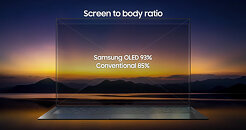Raevenlord
News Editor
- Joined
- Aug 12, 2016
- Messages
- 3,755 (1.19/day)
- Location
- Portugal
| System Name | The Ryzening |
|---|---|
| Processor | AMD Ryzen 9 5900X |
| Motherboard | MSI X570 MAG TOMAHAWK |
| Cooling | Lian Li Galahad 360mm AIO |
| Memory | 32 GB G.Skill Trident Z F4-3733 (4x 8 GB) |
| Video Card(s) | Gigabyte RTX 3070 Ti |
| Storage | Boot: Transcend MTE220S 2TB, Kintson A2000 1TB, Seagate Firewolf Pro 14 TB |
| Display(s) | Acer Nitro VG270UP (1440p 144 Hz IPS) |
| Case | Lian Li O11DX Dynamic White |
| Audio Device(s) | iFi Audio Zen DAC |
| Power Supply | Seasonic Focus+ 750 W |
| Mouse | Cooler Master Masterkeys Lite L |
| Keyboard | Cooler Master Masterkeys Lite L |
| Software | Windows 10 x64 |
Samsung this year aims to bring OLED panels in laptops closer to mainstream, with the company already announcing it would be scaling its OLED screens to serve the 13,3-16" diagonal-craving population with the best visual quality available. The company is apparently aiming to take this further by investing into under-display webcams, which would prevent machines from shipping with large top bezel designs engineered to accommodate them. It also skirts implementation of other, more exotic solutions such as the one found in the Huawei Matebook X Pro - where the webcam is located in a mechanical pop-up on the keyboard area, and mostly shows viewers the inside of your nostrils.
Samsung says that this under-display design should allow laptop makers to achieve up to 93 percent screen-to-body ratio for an immersive viewing experience. Do keep in mind that such a design was implemented only once in the industry in ZTE's Axon 20 smartphone, which incidentally featured diminished selfie camera and display quality due to it being under-display, which even led to resolution compromises on the area of the display that sits over the camera. The idea in ZTE's phone - and is the same for Samsung here - is that the segment of the OLED display that covers the camera will turn translucent whenever the optics are activated. In the ZTE phone, this resulted in clear quality compromises. We'll see if Samsung fares better. There is currently no time to market on such OLED panels, however.



View at TechPowerUp Main Site
Samsung says that this under-display design should allow laptop makers to achieve up to 93 percent screen-to-body ratio for an immersive viewing experience. Do keep in mind that such a design was implemented only once in the industry in ZTE's Axon 20 smartphone, which incidentally featured diminished selfie camera and display quality due to it being under-display, which even led to resolution compromises on the area of the display that sits over the camera. The idea in ZTE's phone - and is the same for Samsung here - is that the segment of the OLED display that covers the camera will turn translucent whenever the optics are activated. In the ZTE phone, this resulted in clear quality compromises. We'll see if Samsung fares better. There is currently no time to market on such OLED panels, however.



View at TechPowerUp Main Site









 .
.